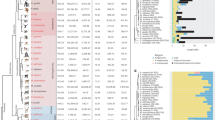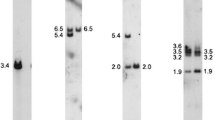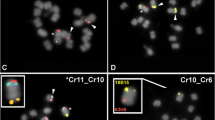Abstract
Several genes located within or proximal to the human PAR in Xp22 have homologues on the Y chromosome and escape, or partly escape, inactivation. To study the evolution of Xp22 genes and their Y homologues, we applied multicolour fluorescence in situ hybridization (FISH) to comparatively map DNA probes for the genes ANT3, XG, ARSD, ARSE (CDPX), PRK, STS, KAL and AMEL to prometaphase chromosomes of the human species and hominoid apes. We demonstrate that the genes residing proximal to the PAR have a highly conserved order on the higher primate X chromosomes but show considerable rearrangements on the Y chromosomes of hominoids. These rearrangements cannot be traced back to a simple model involving only a single or a few evolutionary events. The linear instability of the Y chromosomes gives some insight into the evolutionary isolation of large parts of the Y chromosomes and thus might reflect the isolated evolutionary history of the primate species over millions of years.
Similar content being viewed by others
References
Affara NA, Chambers D, O'Brian J et al. (1989) Evidence for distinguishable transcripts of the putative testis determining gene (ZFY) and mapping of homologous cDNA sequences to chromosome X, Y and 9. Nucleic Acids Res 17: 2987–2999.
Affara NA, Ferguson-Smith MA (1993) DNA sequence homology between the human sex chromosomes. In: Wachtel SS, ed. Molecular Genetics of Sex Determination. London: Academic Press, pp 225–266.
Agulnik AI, Mitchell MJ, Mattei M-G et al. (1994a) A novel X gene with a widely transcribed Y-linked homologue escapes X-inactivation in mouse and human. Hum Mol Genet 3: 879–884.
Agulnik AI, Mitchell MJ, Lerner JL, Woods DR, Bishop CE (1994b) A mouse Y chromosome gene encoded by a region essential for spermatogenesis and expression of male-specific minor histocompatibility antigens. Hum Mol Genet 3: 873–878.
del Castillo J, Cohen-Salmon M, Blanchard S, Lutfalla G, Petit C (1992) Structure of the X-linked Kallmann syndrome gene and its homologous pseudogene on the Y chromosome. Nature Genet 2: 305–310.
Ellis NA, Goodfellow PN (1989) The mammalian pseudoautosomal region. Trends Genet 5: 406–410.
Fisher EMC, Beer-Romero P, Brown LG et al. (1990) Homologous ribosomal protein genes on the human X and Y chromosomes: escape from X inactivation and possible implications for the Turner syndrome. Cell 63: 1205–1218.
Franco B, Meroni G, Parenti G et al. (1995) A cluster of sulfatase genes on Xp22.3: Mutations in chondrodysplasia punctata (CDPX) and implications for warfarin embryopathy. Cell 81: 15–25.
Fraser N. Ballabio A, Zollo M, Persico G, Craig IW (1987) Identification of incomplete coding sequences for steroid sulphatase on the human Y chromosome: evidence for an ancestral pseudoautosomal gene? Development 101(Suppl.): 127–132.
Gläser B, Hierl T, Taylor K et al. (1997) High-resolution fluorescence in situ hybridization of human Y-linked genes on released chromatin. Chrom Res 5: 23–30.
Graves JAM (1995) The origin and function of the mammalian Y chromosome and Y-borne genes-an evolving understanding. BioEssays 17: 311–320.
Incerti B, Guioli S, Pragliola A et al. (1992) Kallman syndrome gene on the X and Y chromosomes: implications for evolutionary divergence of human sex chromosomes. Nature Genet 2: 311–314.
ISCN (1985) An International System for Human Cytogenetic Nomenclature. Harnden DG and Klinger HP, eds, published in collaboration with Cytogenet Cell Genet, Basle: Karger.
ISCN (1995) An International System for Human Cytogenetic Nomenclature. Mitelman F, ed., Basle: Karger.
Jauch A, Wienberg J, Stanyon R et al(1992) Reconstruction of genomic rearrangements in great apes and gibbons by chromosome painting. Proc Natl Acad SciUSA 89: 8611–8615.
Klink A, Schiebel K, Winkelmann M et al. (1995) The human protein kinase gene PKX1 on Xp22.3 displays Xp/Yp homology and is a site of chromosomal instability. Hum Mol Genet 4: 869–878.
Meroni G, Franco B, Archidiacono N et al. (1996) Characterization of a cluster of sulfatase genes on Xp22.3 suggests gene duplications in ancestral pseudoautosomal region. Hum Mol Genet 5: 423–431.
Müller G, Schempp W (1989) Mapping the human ZFX locus to Xp21 by in situ hybridisation. Hum Genet 82: 81–84.
Müller G, Schempp W (1991) Comparative mapping of ZFY in the hominoid apes. Hum Genet 88: 59–63.
Ohno S (1967) Sex Chromosomes and Sex-Linked Genes. Berlin: Springer.
Omoe K, Endo A (1996) Relationship between the monosomy X phenotype and Y-linked ribosomal protein S4 (Rps4) in several species of mammals: a molecular evolutionary analysis of Rps4 homologs. Genomics 31: 44–50.
Page DC, Mosher R, Simpson EM et al. (1987) The sex-determining region of the human Y chromosome encodes a finger protein. Cell 51: 1051–1104.
Rappold GA (1996) Pseudoautosomal regions at the tip of the short and long arms of the human sex chromosomes. In: Verma R, ed. Advances in Genome Biology, Vol. 4. Greenwich, CT, JAI Press pp 205–228.
Salido EC, Yen PH, Koprivnikar K, Yu L-C, Shapiro LJ (1992) The human enamel protein gene amelogenin is expressed from both the X and the Y chromosomes. Am J Hum Genet 50: 303–316.
Sargent CA, Briggs H, Chalmers IJ, Lambson B, Walker E, Affara NA (1996) The sequence organization of Yp/proximal Xq homologous regions of the human sex chromosomes is highly conserved. Genomics 32: 200–209.
Schempp W, Meer B (1983) Cytogenetic evidence for three human X-chromosomal segments escaping inactivation. Hum Genet 63: 171–174.
Schempp W, Weber B, Müller G (1989) Mammalian sex chromosome evolution: a conserved homoeologus segment on the X and Y chromosomes in primates. Cytogenet Cell Genet 50: 201–205.
Schempp W, Toder R, Rietschel W, Grützner F, Mayerová A, Gauckler A (1993) Inverted and satellited Y chromosome in the orangutan (Pongo pygmaeus). Chrom Res 1: 69–75.
Schempp W, Binkele A, Arnemann J et al. (1995) Comparative mapping of YRRM-and TSPY-related cosmids in man and hominoid apes. Chrom Res 3: 227–234.
Schiebel K, Mertz A, Winkelmann M, Gläser B, Schempp W, Rappold G (1997) FISH localization of the human Y-homolog of protein kinase PRKX to Yp11.2 and two pseudogenes to 15q26 and Xq12-q13. Cytogenet Cell Genet (in press).
Schneider-Gädicke A, Beer-Romero P, Brown LG, Nussbaum R, Page DC (1989) ZFX has a gene structure similar to ZFY, the putative sex determinant, and escapes X-inactivation. Cell 57: 1247–1258.
Sibley CG, Alquist JE (1987) DNA hybridization evidence of hominoid phylogeny: results from an expanded data set. J Mol Evol 26: 99–121.
Sinclair AH, Foster JW, Spencer JA (1988) Sequences homologous to ZFY, a candidate sex-determining gene, are autosomal in marsupials. Nature 336: 780–783.
Sinclair AH, Berta P, Palmer MS (1990) A gene from the human sex-determining region encodes a protein with homology to a conserved DNA-binding motif. Nature 346: 240–244.
Taylor K, Hornigold N, Conway D et al. (1996) Mapping the human Y chromosome by fingerprinting cosmid clones. Genome Res 6: 235–248.
Toder R, Zeitler S, Goodfellow PN, Schempp W (1993) Comparative mapping of SRYin the great apes. Chrom Res 1: 117–120.
Toder R, Rappold GA, Schiebel K, Schempp W (1995) ANT3 and STS are autosomal in prosimian lemurs: implications for the evolution of the pseudoautosomal region. Hum Genet 95: 22–28.
Watson JM, Frost C, Spencer JA, Graves JAM (1993) Sequences homologous to the human X-and Y-borne zinc finger protein genes (ZFX/Y) are autosomal in monotreme mammals. Genomics 15: 317–322.
Weber B, Schempp W, Wiesner H (1986) An evolutionarily conserved early replicating segment on the sex chromosomes of man and the great apes. Cytogenet Cell Genet 43: 72–78.
Weber B. Weissenbach J, Schempp W (1987) Conservation of human-derived pseudoautosomal sequences on the sex chromosomes of man and the great apes. Cytogenet Cell Genet 45: 26–29.
Weber B, Walz L, Schmid M, Schempp W (1988) Homoeologic aberrations in human and chimpanzee Y chromosomes inverted and satellited Y chromosomes. Cytogenet Cell Genet 47: 26–28.
Weller PA, Critcher R, Goodfellow PN, German J, Ellis NA (1995) The human Y-chromosome homologue of XG: transcription of a naturally truncated gene. Hum Mol Genet 4: 859–868.
Yen PH, Marsh B, Allen E et al. (1988) The human X-linked steroid sulfatase gene and a Y-encoded pseudogene: evidence for an inversion of the Y chromosome during primate evolution. Cell 55: 1123–1135.
Author information
Authors and Affiliations
Rights and permissions
About this article
Cite this article
Gla¨ser, B., Gru¨tzner, F., Taylor, K. et al. Comparative mapping of Xp22 genes in hominoids – evolutionary linear instability of their Y homologues. Chromosome Res 5, 167–176 (1997). https://doi.org/10.1023/A:1018490713273
Issue Date:
DOI: https://doi.org/10.1023/A:1018490713273




